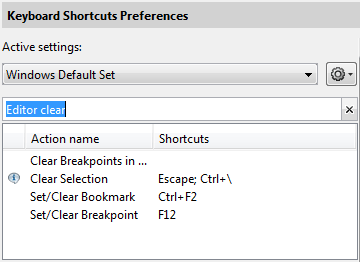自定义键盘快捷方式
您可以在 MATLAB® 中使用“设置”窗口中的“键盘快捷方式设置”页查看和自定义键盘快捷方式。要打开“键盘快捷方式设置”页,请在主页选项卡的环境部分中,点击 设置。然后,依次选择 MATLAB > 键盘 > 快捷方式。
查看操作的快捷方式
要查找某操作的键盘快捷方式,请在“键盘快捷方式设置”页顶部的搜索框中键入操作名称。例如,键入 clear 以查找清除选定文本的键盘快捷方式。MATLAB 显示包含搜索文本的操作及其键盘快捷方式的列表。清除所选内容操作的键盘快捷方式是 Esc 键。
对于作为菜单项可用的操作(例如在工具条或上下文菜单中),您还可以在菜单本身中查看操作的键盘快捷方式。如果某个菜单项未显示键盘快捷方式,则说明该操作不存在键盘快捷方式。

自定义操作的快捷方式
您可以为某操作添加新键盘快捷方式或修改和删除现有的键盘快捷方式。
注意
某些键盘快捷方式无法自定义。无法自定义键盘快捷方式的操作在“键盘快捷方式设置”页上搜索时不会显示。这些操作的示例包括取消当前操作 (Esc)、中断 MATLAB 执行 (Ctrl+C) 以及使用键盘快捷方式导航 MATLAB 中介绍的某些导航操作。
添加快捷方式
要为操作添加键盘快捷方式,请执行以下操作:
在“键盘快捷方式设置”页顶部的搜索框中,键入操作名称或现有键盘快捷方式。您可以通过按键或键入键名称来指定键盘快捷方式。
选择要为其添加键盘快捷方式的操作的名称。
在“快捷方式”列中,点击“添加快捷方式”按钮。
在打开的对话框中,通过按一个或多个修改键(Alt 键、Shift 键或 Ctrl 键)和另一个键的组合输入键盘快捷方式。例如,要输入键盘快捷方式 Ctrl+Shift+Y,请按 Ctrl 键、Shift 键和 Y 键。
要输入特殊键(如 Tab 键或 Esc 键),请点击“添加特殊键”按钮并从可用选项中进行选择。
要为某操作指定多个按键,请选中允许多键快捷方式复选框。当选中允许多键快捷方式复选框时,您可以为一个键盘快捷方式指定最多两个按键。例如,您可以将 Ctrl+Y、Shift+Z 键指定为某操作的键盘快捷方式。
如果您输入的键盘快捷方式与另一个操作的键盘快捷方式冲突,对话框将在“快捷方式冲突”部分中显示冲突。要解决冲突,请更改或删除快捷方式,使每个快捷方式对应唯一操作。
键盘快捷方式冲突并不是必须解决的。但是,如果同一快捷方式指定两个不同操作,可能会混淆使用快捷方式。

点击确定以添加键盘快捷方式。
修改和删除快捷方式
要修改选定操作的现有键盘快捷方式,请双击“键盘快捷方式”列中的键盘快捷方式组合键,或选择它并按 Enter 键以打开“编辑快捷方式”对话框。要删除选定操作的键盘快捷方式,请点击快捷方式右侧的“删除快捷方式”按钮。

还原默认键盘快捷方式
如果您在修改键盘快捷方式之后决定您不保留这些更改,则可以还原默认快捷方式。要还原所有键盘快捷方式的默认状态,请在“键盘快捷方式设置”页中,点击右上角的设置按钮并选择还原默认值。要撤消对特定操作的更改,请选择该操作并点击右侧的“还原默认值”按钮。
使用不同键盘快捷方式集
默认情况下,MATLAB 使用为当前平台定义的键盘快捷方式集。要使用不同键盘快捷方式集,请在“键盘快捷方式设置”页顶部的列表中选择可用集。要使用不在列表中的键盘快捷方式集,请点击设置按钮并选择浏览。
您还可以从 File Exchange 下载键盘快捷方式设置文件。例如,要还原 MATLAB 7.9 版本 (R2009a) 及更早版本中的默认键盘快捷方式,请转至 File Exchange 并搜索 MATLAB 桌面 R2009a 默认键盘快捷方式集。下载并解压缩该集,然后将其选为活动键盘快捷方式集。有效的键盘快捷方式设置文件带有键盘键图标 ![]() 。
。
保存当前键盘快捷方式集
要保存当前键盘快捷方式集,请在“键盘快捷方式设置”页中,点击设置按钮并选择另存为。然后,指定要保存快捷方式的 JSON 文件的名称和位置。
比较键盘快捷方式集
要将当前键盘快捷方式集与其他集相比较,请执行以下操作:
在“键盘快捷方式设置”页中,点击设置按钮并选择将
current集与以下项比较。从菜单中选择要与当前集比较的键盘快捷方式集。
比较工具随即打开,并且并排显示两个键盘快捷方式集。有关如何解释结果的详细信息,请参阅比较文本文件。
创建所有键盘快捷方式的可打印列表
要创建当前键盘快捷方式集的可打印列表,请在“键盘快捷方式设置”页中,点击设置按钮并选择复制到剪贴板。然后,将复制的快捷方式列表粘贴到电子表格应用程序(如 Microsoft® Excel®)或文本文件中。要获得最佳格式,请使用电子表格应用程序。